Kiteboarding Lessons in West Palm Beach: A Guide


Intro
Kiteboarding, a sport that marries the thrill of flying with the rush of surfing, has captured the attention of many adventurers. In West Palm Beach, the conditions are often perfect for both beginners and seasoned kiteboarders. Whether you’re looking to feel the breeze on your face as you glide across the water or seeking a community that shares your passion, learning to kiteboard here sets the stage for years of exhilarating experiences. The following sections will guide you through key aspects of kiteboarding lessons, from selecting the right gear to honing your skills.
Gear Selection
Choosing the right gear is the foundation for a successful kiteboarding experience. With the right equipment, not only will you make the learning process smoother, but you will also enhance your overall enjoyment of the sport.
Types of Kites
The kite you select plays a critical role in your performance and comfort. Here are some types of kites you might encounter:
- C-Kites: Known for their performance in freestyle and big air, these kites give you much pop and lift.
- Bow Kites: They offer a larger wind range, making them great for beginners and casual riders.
- Delta Kites: These kites are versatile and stable, perfect for those still finding their footing.
- Foil Kites: A good option for light wind conditions, these kites glide smoothly and can be used with various boards.
Understanding the characteristics of each type can help you make a more informed choice.
Choosing the Right Board
When it comes to kiteboarding boards, it's not one-size-fits-all. You need to consider your skill level and the type of riding you plan to do.
- Twin Tip Boards: Ideal for beginners, they are symmetrical and easy to control. Perfect for learning the basics and getting comfortable with the sport.
- Directional Boards: Best suited for wave riding and suited for more advanced riders, these boards require specific skills and techniques.
- Foil Boards: These are increasingly popular, allowing you to ride above the water and experience a unique sensation of flying.
Each board has its pros and cons, and it's essential to test a few different types before making a final decision.
Skill Development
Once you've got the gear sorted, skill development comes into play. It's time to hit the water and work on those kiteboarding techniques that will bring out your inner rider.
Essential Techniques
Starting with the basics, focus on these essential skills:
- Kite Control: Understanding how to maneuver your kite is crucial. Practice flying it on land before hitting the water.
- Body Positioning: Keep your knees slightly bent and your weight centered over your board to maintain stability.
- Edge Control: Learn to edge your board effectively to gain speed and control.
Progression Tips
As you get more comfortable, try implementing these tips:
- Set Goals: Whether it’s learning to jump or making your first turn, jot those down.
- Take Lessons: Professional instructions can speed up your learning curve significantly.
- Join a Community: Engaging with local kiteboarding groups can provide support and motivation.
"Practice does not make perfect. Only perfect practice makes perfect."
Preface to Kiteboarding
In the bustling world of water sports, kiteboarding stands out as an exhilarating blend of surfing, paragliding, and windsurfing. It’s not just a sport; it’s a lifestyle, a thrill, and for many, a pathway into a vibrant community. This section of the article delves into what makes kiteboarding a compelling pursuit for both beginners and seasoned riders alike. Every glance at a kiter slicing through waves with a colorful kite soaring overhead draws admiration and ignites a desire to experience the same.
What is Kiteboarding?
Kiteboarding, simply put, is harnessing wind power to propel oneself across water on a board, much like surfing. A sizable kite is flown while the rider skims along the surface, propelled by the wind's force captured in the kite. To put things in perspective, imagine gliding swiftly through the water, feeling the wind against your skin, and the thrill of jumping high into the air, all while mastering the art of balancing board and kite. At its core, kiteboarding combines various elements — skill, technique, and a deep understanding of wind behavior.
For beginners, learning kiteboarding involves understanding several key components, including:
- The anatomy of a kite
- Wind direction and how it affects riding
- Equipment familiarity, including harnesses and boards
- Safety measures and protocols to ensure a safe ride
Getting a grasp on these elements not only enhances the learning process but also ensures that riders can fully enjoy the sport while minimizing risks.
History and Evolution of Kiteboarding
The origins of kiteboarding trace back to the late 1970s, when enthusiasts began experimenting with kites for recreational water activities. This piqued interest evolved over decades, transitioning from simple kites to complex designs optimized for performance. The 1990s saw the advent of modern kiteboarding, spearheaded by innovative thinkers who integrated ideas from paragliding and surfing. It was a revolutionary period where riding techniques and equipment began to take a familiar shape.
In the beginning, riders used inflatable kites, which significantly improved safety and performance. As time rolled on, variations such as directional boards and twin-tips emerged, broadening the spectrum of riding styles available to enthusiasts. Today, kiteboarding continues to evolve, embracing cutting-edge materials and technology to enhance performance and ensure riders remain safe on the water.
The transformation of kiteboarding reflects a beautiful journey where passion meets innovation, making it a unique sport rich in history and promise.
With its deep roots and thriving global community, kiteboarding in places like West Palm Beach offers the perfect blend of ideal conditions and an enthusiastic culture ready to welcome newcomers into the fold. Learning the fundamentals through proper lessons enhances not only one's skill but also appreciation for the sport's heritage and future.
Why Choose West Palm Beach for Kiteboarding Lessons?
When it comes to learning kiteboarding, the location can make all the difference. West Palm Beach isn't just a pretty face in Florida; its unique attributes shine bright for anyone serious about mastering this thrilling sport. From its ideal climate to its stunning scenery, this destination offers a wealth of opportunities that both newcomers and seasoned flyers appreciate.
Ideal Climate and Wind Conditions
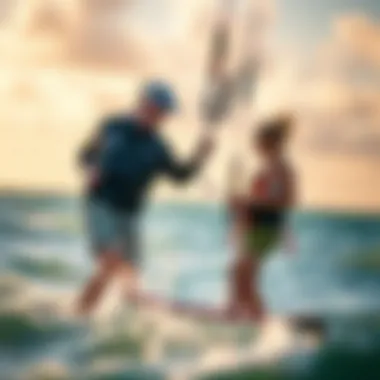
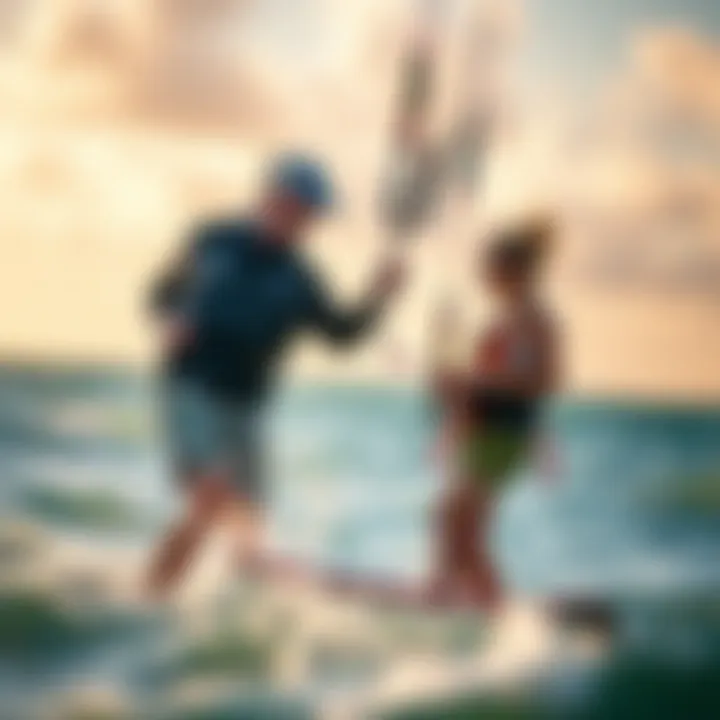
In West Palm Beach, it's like Mother Nature has rolled out the red carpet for kiteboarders. The weather is favorable nearly year-round, significantly reducing the waiting time for an ideal lesson day. Winds typically blow in from the east or southeast, averaging around 15 to 25 knots, which suits kiteboarding perfectly.
These consistent conditions create an inviting environment for learners. The robust breeze helps novices grasp the nuances of kite control while pushing their skills right from day one. Even during the summer months, when temperatures can reach up to the mid-90s Fahrenheit, the sea breeze provides a refreshing relief, keeping riders cool as they get up on the board.
But it’s not just the winds that appeal; the absence of intense storms during peak riding seasons ensures that safety remains a top priority. Riders can train without fear of sudden weather changes, making the lessons effective and enjoyable.
"Kiteboarding in West Palm Beach feels easy. The wind is like an old friend—reliable and steady," says Jane, a local instructor with years of experience.
Scenic Locations for Learning
Learning to kiteboard in a visually appealing setting certainly enhances the experience. In West Palm Beach, you'll encounter breathtaking spots that are as favorable for kiteboarding as they are for enjoying the great outdoors.
One standout location is Singers Island, with its sandy beaches and crystal-clear waters. The gradual depth of this area allows beginners to practice without the worry of deep water immediately below. Another gem is Lake Worth, which sometimes resembles a vast blue playground for kiteboarders. Its lush backdrop elevates the entire learning experience.
Consider also the popular Flagler Drive, where you can catch a taste of coastal living coupled with stunning views as you ride. The vibrant atmosphere adds to the thrill of learning while connecting you to the local riding community.
Whether you're absorbing the sun's rays or catching sight of colorful kites against a flawless sky, these environments offer more than just practical training; they create lasting memories and inspire a passion for the sport. In short, West Palm Beach isn’t merely a location; it’s an experience that envelops you into the kiteboarding lifestyle.
Types of Kiteboarding Lessons Available
Kiteboarding, as thrilling as it seems, can be quite daunting for beginners. This is where structured lessons come in. By understanding the different types of lessons available, aspiring kiteboarders can choose the one that fits their learning style and goals best. Each lesson type offers unique advantages, ensuring that beginners and advanced riders alike can enjoy a comprehensive learning experience while navigating the beautiful waters of West Palm Beach.
Group Lessons
Group lessons are a fantastic way to ignite the spark of kiteboarding. Designed for beginners, these sessions typically involve multiple students, offering a social and supportive environment. Having fellow learners around can ease nerves and provide a sense of camaraderie.
- Cost-effective: Often, group lessons are more affordable than private sessions, making them accessible to a wider audience.
- Shared Learning: Group dynamics allow students to learn from one another, sharing experiences and challenges.
- Social Interaction: Learning with others can help build friendships, creating a supportive community from the get-go.
While group lessons can be beneficial, it’s essential to understand that the instructor may not dedicate as much one-on-one time to each student. However, this format works well for individuals who thrive in social settings and enjoy learning alongside others. If you’re the type who loves to ride the waves with a crowd, group lessons might just be the ticket.
Private Lessons
For those who wish for tailored instruction, private lessons provide a personal touch that can significantly speed up the learning process. During these sessions, the instructor focuses solely on the individual’s needs, offering a bespoke kiteboarding experience.
- Personalized Attention: You get immediate feedback and can work at your own pace, focusing on specific skills that you want to improve.
- Flexible Scheduling: Private lessons can often be scheduled at your convenience, allowing for a more relaxed approach to learning.
- Faster Progression: With undivided attention from the instructor, many find they progress much quicker in their skills.
Private lessons are particularly appealing to those who might feel shy or overwhelmed in group settings, or to more experienced riders looking to fine-tune their techniques. It's all about aligning your learning with your personal goals.
Advanced Training Courses
Once the basics are down, some kiteboarders might feel the itch for more advanced skills. This is where advanced training courses come in. These lessons dive deeper into specialized techniques, tricks, and safety maneuvers.
- Trick Mastery: These courses often focus on advanced tricks, helping riders hone their aerial maneuvers or transitions that can impress onlookers.
- Safety in Complexity: As skills become more complex, learning the associated safety measures is crucial. These courses usually address potential risks and how to mitigate them effectively.
- Community of Experts: Joining an advanced course can also connect students with fellow enthusiasts who share similar goals, fostering a community of like-minded individuals.
Advanced training often requires foundational knowledge, so these courses are ideal for those who have already learned the ropes and wish to take their abilities to new heights.
In summary, whether you choose group lessons for a fun social experience, private lessons for individualized instruction, or advanced courses to perfect specialized skills, West Palm Beach offers a rich variety of options for kiteboarding enthusiasts. Embrace the wind, and choose the path that best matches your aspirations!
Finding Qualified Instructors in West Palm Beach
When diving into the vibrant world of kiteboarding, the choice of instructor can make all the difference. The right coach not only helps you refine your skills, but also ensures safety and proper technique from the get-go. With the sheer range of instructors available in West Palm Beach, finding someone who truly fits your learning style is crucial. A well-qualified instructor can transform a daunting experience into an exhilarating one.
Key Qualifications to Look For
- Certifications and Experience: It’s essential to check if the instructor has valid certifications from recognized kiteboarding organizations. Certifications like those from the International Kiteboarding Organization often show a high level of professionalism. Experience plays a big role too; you’d want someone who’s not only a proficient rider but also has extensive teaching experience.
- Teaching Style: Every learner is unique; what works for one might not suit another. Some may prefer a laid-back approach, while others thrive under structured lessons. Before committing, try discussing your expectations with instructors. This can give you a good feel for their teaching method and whether it aligns with your learning preference.
- Safety Awareness: A qualified instructor will prioritize safety—yours and theirs. They should provide appropriate safety briefings and possess thorough knowledge of emergency protocols. In kiteboarding, conditions can change rapidly, so having an instructor who's calm under pressure can be a game changer.
- Local Knowledge: Instructors familiar with the waters of West Palm Beach can offer insights that will enhance your learning experience. They know the local winds, tides, and hazards, which is invaluable when you're just starting out.
"A good instructor not only teaches you how to kite but also shows you how to love the experience."
Top Kiteboarding Schools in the Area
Finding the right school is just as important as finding the right instructor. Here are some of the most reputable kiteboarding schools in West Palm Beach.
- Kiteboarding School Florida: This school is widely praised for its comprehensive programs catering to all skill levels. Their instructors are certified and often engage in friendly banter to ease the nerves of beginners, making students feel right at home.
- Palm Beach Kiteboarding: Known for its state-of-the-art equipment and enthusiastic instructors, this school emphasizes not just learning, but also fun. They often host group lessons which foster a sense of community among learners.
- Kite House: Nestled along the beautiful shores of West Palm Beach, Kite House combines professional training with an appreciation of nature. They focus on sustainability and responsible riding, which is ideal for eco-conscious learners.
Choosing the right school and instructor will greatly boost your kiteboarding journey, ensuring you not only learn effectively but also enjoy every bit of it in the stunning surroundings of West Palm Beach.
Essential Kiteboarding Gear
Kiteboarding is a thrilling activity that brings joy to countless water sports enthusiasts. However, to fully embrace the exhilaration of this sport, having the right gear is crucial. Kiteboarding gear not only enhances your performance but also ensures your safety while you indulge in this adrenaline-fueled pastime.
Kites: Types and Features
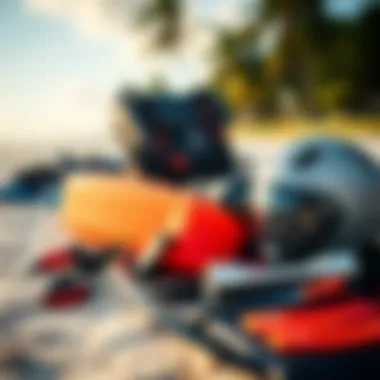
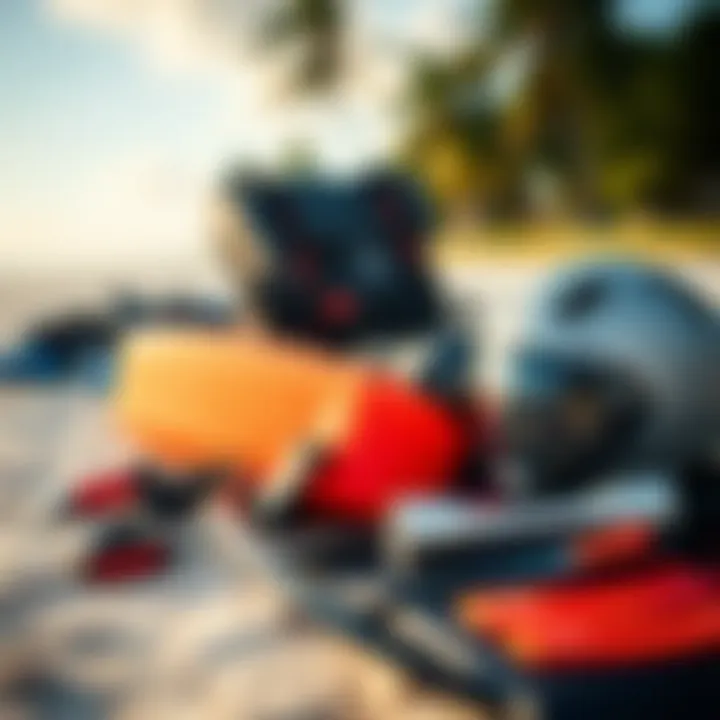
When it comes to kites, the variety might leave you scratching your head. In general, you should know that they come in several designs, each serving a unique purpose.
- Inflatable Kites: These are the most common type, known for their ease of use and stability in various wind conditions. Commonly used for freestyle and wave riding, they offer a great balance between power and control.
- LEI Kites (Leading Edge Inflatable): Perfect for beginners and advanced riders alike, these kites feature an open leading edge that allows for easy relaunch from the water. They come in numerous sizes, making them suitable for diverse wind conditions.
- Foil Kites: Unlike inflatable kites, foil kites are made of soft materials and do not have a rigid structure. They are favored for their lightweight design and efficiency, especially for light wind conditions.
Features to consider include sizing, control bar length, and the number of lines. A kite's size impacts the lift and power it provides, with larger kites generating more power in lighter winds. Ultimately, selecting the right kite involves understanding your skill level and the specific conditions under which you'll be riding.
Boards: Choosing the Right One
The board you ride on can significantly affect your kiteboarding experience. With various boards available, here's how to choose the one that fits you best:
- Twin-Tip Boards: Most beginner kiteboarders start with twin-tips due to their versatile design that allows riding in both directions. They offer stability and are excellent for learning basic maneuvers.
- Directional Boards: These boards resemble traditional surfboards and are designed for wave riding. They provide a unique riding experience but require a bit more skill to master.
- Lightweight vs. Durable Materials: Some boards are made from lighter materials, allowing for easy handling and higher jumps. Others are built with durability in mind, making them suitable for harsher environments.
Before making a purchase, consider factors like your riding style, type of water conditions, and personal preference. Furthermore, trying out different boards at a rental shop can provide valuable insights into what works best for you.
Safety Equipment: What You Need to Know
While kiteboarding can be a blast, safety should always be at the forefront.
- Harness: A good harness allows you to comfortably connect to the kite and is essential for distributing the pull evenly across your body, reducing the fatigue that can plague your ride. There are two kinds: waist harnesses, which are great for a variety of styles, and seat harnesses, which offer extra support for those who prefer a more stable experience.
- Helmet: Wearing a helmet is wise, especially for beginners who may still be working on controlling their kites. It protects your head from unexpected falls or collisions.
- Impact Vest or Buoyancy Aid: These not only provide additional floatation in case you find yourself in the drink but also shield your torso during hard landings.
- Leash: A leash connected to the kite helps prevent it from drifting away if you crash. This can save you a lengthy swim back to catch your kite.
Investing in quality safety gear is not just about your own safety but also ensuring the well-being of those around you on the water.
"Being prepared with the right gear is just as important as mastering the skills. It enhances your performance and keeps kiteboarding fun and safe!"
By understanding the essential gear needed for kiteboarding, you'll be well on your way to enjoying the surf in West Palm Beach with confidence. Take your time to choose wisely, considering your comfort and safety above all.
For further resources on gear selection, you may check Kiteboarding.com, or visit forums like Reddit's Kiteboarding for insights from the community.
Understanding Kiteboarding Safety Practices
In the thrilling world of kiteboarding, safety is as paramount as skill. Engaging with this wind-driven sport comes with its share of exhilaration, but it also demands respect for the elements and understanding of potential risks. Recognizing these aspects enhances your experience and ensures a safer journey through learning and mastering the sport.
Kiteboarding safety practices encompass a variety of elements, from pre-boarding checks to situational awareness while on the water. By internalizing these principles, novices and seasoned riders alike can navigate their kiteboarding adventures confidently, minimizing hazards.
"Remember, it’s not just about riding the wind; it’s about riding it safely."
Common Risks and Precautions
As thrilling as it is, kiteboarding can present dangers if not approached with caution. Some common risks include:
- Equipment Failure: High winds, rapid descents, or wear and tear on kites and lines can lead to accidents.
- Water Hazards: Shallow reefs, rocks, or other submerged objects can pose a threat to riders who are not aware of their surroundings.
- Changing Weather Conditions: Sudden shifts in wind speed or direction can catch riders off guard, leading to accidents.
- Collisions with Other Riders or Boats: Being on crowded waters can increase the chances of encounters with other kiteboarders or marine traffic.
To mitigate these risks, kiteboarders should take several precautions:
- Conduct Thorough Gear Checks: Before hitting the water, inspect all your equipment rigorously. Ensure lines are not frayed, and kites are not punctured.
- Learn Your Environment: Familiarize yourself with the local conditions and potential hazards in the area you’re riding.
- Supervisory Support: When learning or attempting new tricks, having an experienced partner watch your sessions can provide valuable feedback and ensure safety.
- Continuous Learning: Participate in safety courses and read up on first aid and emergency response related to kiteboarding mishaps.
Safety Protocols for Lessons
Lessons are foundational for all beginners. A structured approach under professional instructors can significantly enhance understanding and safety within the sport. Safety protocols commonly observed in lessons include:
- Pre-Lesson Briefing: This typically involves an overview of safety measures, understanding the kite’s controls, and situational awareness tips to prepare for the water.
- Controlled Environments: Beginners often start in designated areas where hazards are minimized and instructors can provide immediate assistance.
- Use of Safety Gear: Instructors ensure all students are equipped with vests, helmets, and safety release mechanisms. This equipment enhances protection against falls and accidents.
- Simulations: Many instructors conduct practice drills on land before moving to the water, allowing students to familiarize themselves with equipment handling.
Community and Culture in West Palm Beach Kiteboarding
Kiteboarding in West Palm Beach is not just a sport; it's a vibrant community that thrives on shared experiences and values. This section delves into the intricate social fabric that links riders, instructors, and enthusiasts alike, exploring how these connections enhance the entire kiteboarding experience.
Local Events and Competitions
Local events are the heartbeat of the kiteboarding culture in West Palm Beach. These gatherings do more than just showcase skills; they foster camaraderie among participants. Events range from friendly competitions to showcases of advanced tricks, inviting everyone from novices to seasoned pros. Competitions often feature awards for categories like best trick, fastest time, and even creativity in presentation. Such events not only highlight individual talent but also reinforce the community’s support system. Participants often work together to organize and promote these events which cultivates a sense of ownership and pride among locals.
A couple of annual events stand out:
- West Palm Beach Kite Fest: This festival attracts kiteboarders from all over, including amateurs just getting their feet wet and professionals chasing points in regional rankings.
- Local Beach Days: Informal meet-ups happen regularly, allowing riders to exchange tips, learn new tricks, and just enjoy each other's company on the water.
Whether it's competing for glory or cheering each other on, local events are perfect opportunities to build connections and friendships that last beyond the water.
Connecting with Other Riders
The essence of community in West Palm Beach Kiteboarding is deeply rooted in the connections that kiteboarders foster among themselves. Through local shops and schools, meeting fellow riders becomes less of a quest and more of a natural process. These establishments frequently host workshops, social gatherings, and group outings, providing the perfect melting pot for kiteboarders of all levels.
Sharing knowledge plays a crucial role here. Experienced riders often mentor newcomers, sharing insights ranging from gear choices to mastering tricky maneuvers. For those who might feel a little shy about facing advanced techniques, this mentoring creates a safe space for learning and growth. Rider meet-ups often occur, where everyone can share their latest adventures or even challenges faced on the water. These interactions not only improve individual skills but also strengthen the fabric of the kiteboarding community.
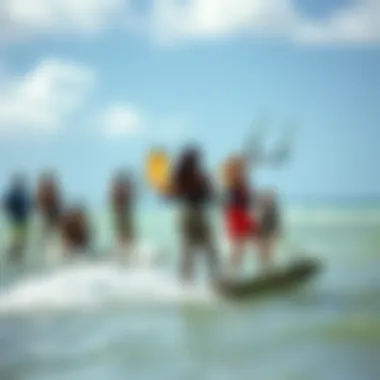
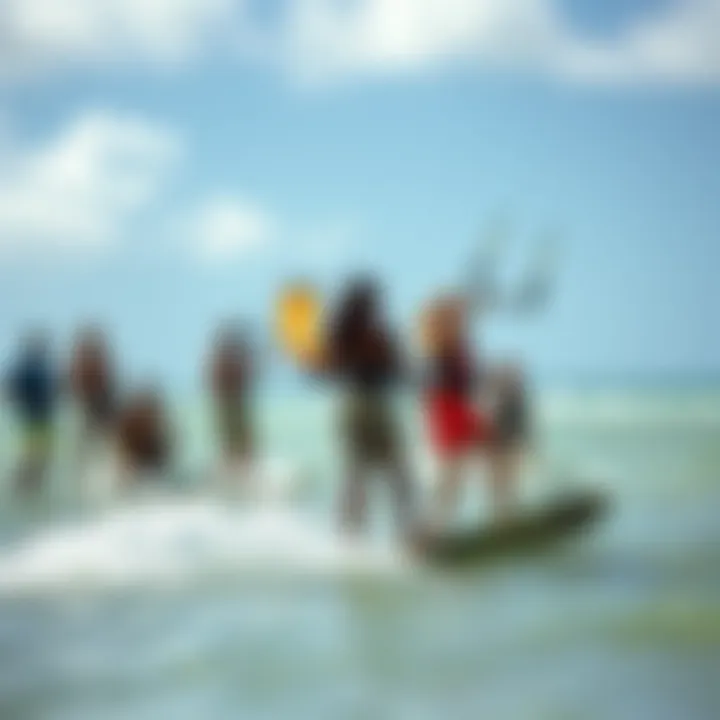
To stay connected, consider checking out forums and social media groups where local riders share experiences, advice, and even organize impromptu beach sessions. Engaging with the community online can enhance your opportunities to connect in real life. Websites like Reddit or local Facebook groups are excellent resources for upcoming events or gatherings.
In short, the community and culture surrounding kiteboarding in West Palm Beach enrich the sport experience. It creates bonds that enhance not just the learning process but foster friendships that ride the waves long after the sun sets.
Tips for Mastering Kiteboarding Skills
Kiteboarding, being a dynamic and thrilling sport, requires more than just a passion for the wind and water. Getting a grasp of the core skills is pivotal to improving your proficiency. This section discusses essential tips for mastering kiteboarding skills, which can help you effectively progress from the initial stages to becoming a confident rider.
Basic Tricks and Techniques
Starting with the fundamentals is crucial for any kiteboarder. Basic tricks are typically the gateway to more complex maneuvers. Here are some fundamental techniques that can set the stage for your kiteboarding adventure:
- Body Dragging: This is often the first technique taught. It’s an essential skill that teaches you how to maneuver without a board. Practice body dragging downwind, then switch directions. This skill is not only vital for re-entering the water with your board but also helps you understand how the kite pulls you and how to control it.
- Water Start: A key part of getting on your board. Position yourself properly in the water, hold the kite steady, and use its power to lift you up. Once you master this, getting up on your board becomes less daunting.
- Riding Upwind: Learning to ride upwind is a significant milestone. It enhances your control and allows you to cover more distance rather than relying on a rescue.
- Basic Turns: Understanding how to turn effectively while riding opens up new horizons. Practice both heel-side and toe-side turns, as they are fundamental to developing a fluent riding style.
Each of these techniques is interlinked, and with repetition, you'll find yourself getting more comfortable and confident.
Progressing to Advanced Moves
Once you've established a solid foundation, it's time to take the leap into more advanced maneuvers. These can elevate your kiteboarding experience and provide a greater sense of accomplishment. Here’s a peek into what you can work towards:
- Jumping: This is the first taste of aerial thrills in kiteboarding. Start by practicing small jumps, focusing on timing and kite control. As you progress, aim for higher, longer jumps while maintaining balance and landing smoothly.
- Board Off Tricks: Once you've mastered jumps, consider trying board off moves. This involves getting air while removing your feet from the board. It looks impressive and significantly boosts your skillset.
- Spins: Adding spins to your jumps creates a flair that showcases your style. Start with 180-degree spins and gradually progress toward more complex rotations like 360s.
- Kiteloops: For those adventurous enough, learning to perform kiteloops can provide the ultimate thrill. This requires precise control and timing but, when done correctly, sends you soaring through the air with the kite looping beneath you.
Mastery in these advanced moves requires patience and practice, paired with a clear understanding of the mechanics of kite control.
"The only way to truly master kiteboarding is to embrace both the failures and the successes along your journey. Each session will teach you something new."
By steadily focusing on these skills, not just during lessons but also while riding in your own time, you’ll notice considerable growth in your techniques. The more you immerse yourself in kiteboarding fundamentals, the more rewarding the journey will become as you progress.
Environmental Considerations for Kiteboarding
When it comes to enjoying kiteboarding, it's easy to get caught up in the thrill and excitement of the sport. However, it’s important not to overlook the environmental impact this exhilarating activity can have. Understanding and implementing environmentally friendly practices is key for sustaining not only the sport but also the natural beauty that draws many to West Palm Beach's waters.
Kiteboarding, while a fun way to engage with nature, can disrupt local ecosystems if proper care isn’t taken. This section will explore sustainable practices and conservation efforts that help mitigate these impacts, ensuring that future generations can enjoy kiteboarding just as we do today.
Sustainable Practices and Responsible Riding
Sustainable practices in kiteboarding encompass a range of behaviors that protect the environment while still allowing for enjoyment of the sport. Some of these practices include:
- Respect Wildlife: Always be aware of local wildlife such as birds and marine life. Keeping a safe distance helps to prevent unnecessary stress or harm to these creatures.
- Stay on Designated Paths: Use established launch sites and riding areas to minimize disturbance to sensitive habitats. Riding in restricted zones risks harming fragile ecosystems.
- Dispose of Waste Properly: Never leave behind any trash on the beach or the water. Use designated waste containers or take your rubbish with you.
- Conserve Water: During lessons or sessions, be mindful of water use, especially in areas prone to drought or where water quality is a concern.
One might think these practices are just common sense, but sometimes the rush of excitement can make it easy to forget. As a rider, prioritizing these sustainable practices is a step toward fostering a culture of responsibility within the kiteboarding community.
Conservation Efforts in West Palm Beach
The West Palm Beach area is not only a popular kiteboarding destination but also home to a variety of local initiatives aimed at ecological preservation. Understanding these efforts helps riders engage more deeply with the environment they enjoy. Here are some prominent conservation efforts in the area:
- Beach Clean-Up Events: Many local organizations arrange regular clean-up days on local beaches. Participating in these events is an excellent way for kiteboarders to contribute positively to their favorite spots.
- Education Programs: Schools and organizations often conduct educational workshops on marine conservation and the importance of preserving marine habitats. Getting involved in such programs boosts awareness and knowledge among the kiteboarding community.
- Partnership with Environmental Agencies: Cooperation between local schools and environmental groups promotes sustainable riding practices among kiteboarders, ensuring that riders understand the balance between enjoyment and environmental stewardship.
Kiteboarding doesn’t just offer a thrill – it offers an opportunity to foster environmental stewardship and make a positive impact.
Thus, being aware of how one’s actions affect the environment is crucial. By engaging in and supporting local conservation efforts, kiteboarders can help protect the coastal waters of West Palm Beach and preserve its kiteboarding allure for many years to come.
For more information on specific initiatives and events, consider checking out resources like the Florida Department of Environmental Protection, local environmental advocacy groups on Facebook, or community forums on Reddit.
Ending
Kiteboarding is not just a sport; it embodies adventure, freedom, and community. West Palm Beach provides fertile ground for anyone looking to dive into this exhilarating world. Throughout this comprehensive guide, we've explored various angles, making sure to cover everything from the basics of kiteboarding, and why West Palm Beach stands out as an ideal location, to the intricate details of gear, safety, and community.
It’s crucial to understand that kiteboarding lessons serve as the foundation for both safety and skill development. Starting under the guidance of qualified instructors not only accelerates the learning curve but also instills confidence to navigate the waters independently. As you gain knowledge about equipment and safety protocols, the overall experience becomes richer and more enjoyable.
Kiteboarding isn't just about mastering tricks; it’s about connecting with nature, understanding wind patterns, and forming lasting bonds with fellow kiteboarders. All these contribute to a rewarding experience that goes beyond the water. Those considering kiteboarding in West Palm Beach should feel equipped to dive in, thanks to the insights shared herein.
"The thrill of riding the wind is like no other; it’s an art that connects you with nature."
Recap of Key Points
In this article, we covered the following key aspects:
- An overview of what kiteboarding encompasses and its historical background.
- The advantages of choosing West Palm Beach, focusing on its favorable climate and stunning scenery.
- Various types of lessons available, including group and private sessions tailored to all skill levels.
- Important gear considerations, emphasizing the right choice of kites and boards, as well as safety equipment.
- Community engagement, showcasing local events and ways to connect with riders.
- Environmental consciousness and sustainable practices in kiteboarding.
Looking Ahead: The Future of Kiteboarding in West Palm Beach
As we gaze towards the horizon, the future of kiteboarding in West Palm Beach presents a promising landscape. The local community is poised to grow, supported by increasing interest in water sports and advancements in kiteboarding technology. Furthermore, ongoing initiatives to promote environmental responsibility among riders will ensure that this sport remains viable for generations to come.
Instructors are constantly evolving their teaching methods, integrating current technology and knowledge about safety, which means new learners can expect a safer yet exhilarating introduction. Local events are likely to gain popularity as kiteboarding enthusiasts gather, fostering a vibrant culture that appeals to both novices and seasoned riders alike.
Overall, the future shines brightly for kiteboarding here, inviting individuals to be part of a unique culture that celebrates both adventure and community.















